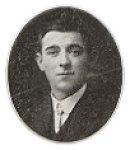After his father had died (sometime prior to 1900) Joseph and his family moved to live in St Ives where his mother had relatives. It was in St Ives that Joseph joined the Boy's Brigade. In about 1900 Joseph's mother married for a second time, to Robert Davies. Davies was an insurance agent when the couple had a child, John Morgan Davies, in St. Ives on 31 July, 1903.
By this time Joseph's elder brother had married and emigrated to Kearsarge near Calumet, Houghton County, Michigan. Robert Davies died in 1910, and the decision was made that the family should emigrate and join Richard in Michigan. Joseph had planned to take in lodgers there to supplement his mother's income she having sold most of the family possessions to fund their move to America. He travelled from St Ives with his mother and young half-brother and family friend Maude Sincock from nearby Halsetown. Maude was joining her father in Hancock, near Kearsarge.
The group boarded the Titanic at Southampton as second class passengers (ticket number 33112, £36 15s.20). Joseph was in a cabin separate from his mother and half brother.
On the night of the tragedy Joseph came to his mother's stateroom and helped his mother and brother to put their lifebelts on. They all went up on deck about 12.15 where Joseph's mother and brother were placed in a lifeboat. Joseph had asked permission to enter the boat himself but was refused with the threat that he would be shot if he attempted to get in.
Joseph was lost in the sinking. On 23 April 1912 Joseph's body was recovered from the sea by the MacKay Bennett. The body was buried at sea as identification proved difficult at the time; the possessions removed from the body were taken to Halifax, Nova Scotia. It was here that the possessions were identified as belonging to Joseph Nicholls by the brothers of fellow passenger William Carbines.
After his father had died (sometime prior to 1900) Joseph and his family moved to live in St Ives where his mother had relatives. It was in St Ives that Joseph joined the Boy's Brigade. In about 1900 Joseph's mother married for a second time, to Robert Davies. Davies was an insurance agent when the couple had a child, John Morgan Davies, in St. Ives on 31 July, 1903.
By this time Joseph's elder brother had married and emigrated to Kearsarge near Calumet, Houghton County, Michigan. Robert Davies died in 1910, and the decision was made that the family should emigrate and join Richard in Michigan. Joseph had planned to take in lodgers there to supplement his mother's income she having sold most of the family possessions to fund their move to America. He travelled from St Ives with his mother and young half-brother and family friend Maude Sincock from nearby Halsetown. Maude was joining her father in Hancock, near Kearsarge.
The group boarded the Titanic at Southampton as second class passengers (ticket number 33112, £36 15s.20). Joseph was in a cabin separate from his mother and half brother.
On the night of the tragedy Joseph came to his mother's stateroom and helped his mother and brother to put their lifebelts on. They all went up on deck about 12.15 where Joseph's mother and brother were placed in a lifeboat. Joseph had asked permission to enter the boat himself but was refused with the threat that he would be shot if he attempted to get in.
Joseph was lost in the sinking. On 23 April 1912 Joseph's body was recovered from the sea by the MacKay Bennett. The body was buried at sea as identification proved difficult at the time; the possessions removed from the body were taken to Halifax, Nova Scotia. It was here that the possessions were identified as belonging to Joseph Nicholls by the brothers of fellow passenger William Carbines.
Family Members
Sponsored by Ancestry
Advertisement
Explore more
Sponsored by Ancestry
Advertisement









